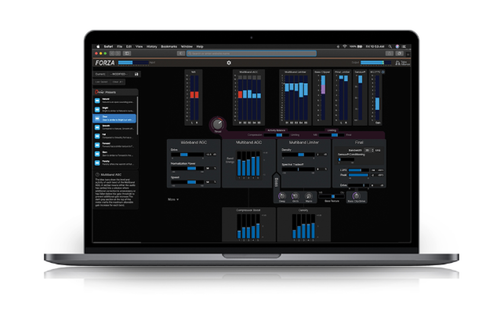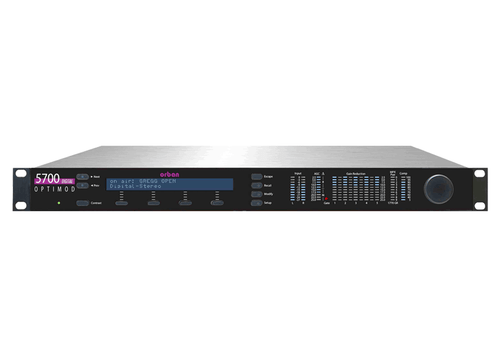Overview
Omnia Forza-FM - FM/HD-1 - Multiband Processor Container License
Omnia Forza breathes new life into the traditional five-band processor design, featuring all-new AGCs and multiband limiters. As a software processor, Forza is delivered via a Docker container that can be deployed on-premises on a COTS (commercial off-the-shelf) server or cloud-hosted.
The use of expertly crafted launch point presets and an intuitive yet powerful user interface based on “smart controls” seamlessly maintains harmony between under-the-hood controls and settings. This integrated control design means anyone can drive Forza with confidence, and ensures instant sonic excellence for listeners. More advanced users will find the tools they need to craft their unique signature sound.
Forza is an AoIP-native processor utilizing Livewire+AES67 standards, and built for server-based, scalable facility designs embraced by forward-thinking professionals. Forza comes in two base versions, covering every broadcast scenario and workflow.
Forza HDS
Forza HDS is specifically designed for L/R audio applications like HD-2/3/4, DAB, and streaming. It provides a consistent and polished audio signature without sounding overly processed. An integrated, target-driven ITU-R BS.1770 loudness controller makes conforming to emerging streaming loudness requirements a set-and-forget process. For those wanting the benefits of a virtualized software processor but with the simplicity of pre-configured hardware, up to four instances of Forza HDS processing can be pre-installed on the Telos Alliance AP-3000 platform.
Forza FM
Forza FM builds upon the foundation of the HDS (HD/DAB/Streaming) version by adding features necessary for FM broadcast applications, including HD-1/DAB. The Frank Foti-designed Silvio FM clipper from Omnia.11 delivers the powerful on-air sound users have come to expect from Omnia processors. A built-in diversity delay is included to time-align the FM signal to the HD-1 output. The integrated stereo generator includes RDS, and outputs include FM composite over IP and µMPX.
Buyout Option Requires a 1 year SLA for TelosCare+, this is included in price
Subscription Includes 1 year SLA for TelosCare+.
Features
- Legendary Omnia audio quality
- Wideband AGC, 5 bands of multiband AGC, 5 bands of multiband limiting, plus soft and hard bass clippers
- Comprehensive bass management controls
- LUFS target-driven ITU-R BS.1770 loudness controller and True Peak limiter for compliance with streaming platform requirements (Forza HDS)
- Frank Foti-designed Silvio FM clipper and stereo generator with integrated RDS (Forza FM)
- FM/HD-1 diversity delay (Forza FM)
- Omnia’s highly regarded Sensus® conditioning for low bitrate streams and HD Radio
- Carefully crafted Omnia presets ensure great-sounding audio on all types of formats and programs
- “Smart Controls” combine the adjustment of multiple, interrelated parameters into a single knob or slider
- Innovative single-page GUI welcomes less-experienced users while still providing the tools processing experts expect and need
- Browser-based HTML5 UI works on any device, including Windows and MacOS computers and Android and iOS smartphones and tabletsOptional Kantar and Nielsen watermarking
In Depth
Audio processing software isn’t a new idea, nor is it a totally new concept for Telos Alliance. But historically, software processors have been based upon existing hardware products and often limited to a single deployment style. Forza breaks from that tradition as a processor that was purpose-built as software.
It can be delivered as a Docker container, allowing it to take advantage of the many benefits of virtualization, whether on-premises, cloud-hosted, or available in 3rd party integrations. For those wanting the benefits of virtualization but with the simplicity of pre-configured hardware, up to four instances of Forza HDS processing can be pre-installed on the Telos Alliance AP-3000 platform. For developers interested in integrating Omnia’s best-of-breed processing into their own offerings, an API is also available for custom OEM integration.
Forza for HD/DAB/Streaming and FM
Forza HDS is an L/R stereo processor optimized for HD-2/3/4, DAB, and streaming audio applications. Its integrated, target-driven ITU-R BS.1770 loudness controller makes conforming to emerging streaming loudness requirements a set-and-forget process. As an ever-increasing number of listeners move to online listening and Internet streams are natively available on automotive dashboards, proper audio processing becomes just as essential for this platform as it is for FM transmission. Sonically, Forza HDS is consistent, polished, natural, and seemingly unprocessed.
Forza FM employs the same fundamental five-band approach but is optimized for the unique demands of FM, taking into account the pre-emphasis curve and the need to build loudness and RMS energy. The built-in stereo generator with integrated RDS includes Frank Foti’s Silvio clipper from the Omnia.11 to provide the clean, open, yet dial-dominating loudness users expect from an Omnia processor. A separate processed L/R peak-limited output is included for HD-1 and DAB.
Forza’s Simple But Powerful UI
Anyone can design a complex user interface, and that’s one of the problems with many specialized products. Audio processing is a particularly challenging example, where hundreds of interrelated parameters spread across multiple tabs, layers, and screens can result in a UI that many users find intimidating or frustrating. Combine this with the inherent difficulties of sonic tuning, where you can’t see the goal, only hear it, and must rely on language borrowed from the visual fields to describe the sound with words like “clear”, “muddy”, or “bright”, and things become even more challenging. Moreover, what constitutes “great sound” can be highly subjective.
Historically, the answer has been to call on an audio processing “guru” to wrangle all this complexity into a cohesive sonic goal, but such expertise is becoming increasingly rare. The truth is that the broadcasting industry is experiencing an engineering shift, and the presence of “traditional” radio engineers who have learned even the basics of audio processing through time-consuming experimentation, apprenticing, and good old-fashioned trial and error is no longer a given. In many of today’s operations, digital and streaming audio is deployed and managed by an IT-centric department completely separate from terrestrial broadcast.
These are the realities that led the Omnia team to take an unconventional design approach with Forza, refining our decades of processing experience into a democratized tool. Forza’s UI is purposefully engineered to distill a complex system with hundreds of underlying parameters into a lean, high-level control set where the entire user interface - including all meters and controls - is presented on a single HTML5 web page. To support this, we leveraged the concept of interdependent “smart controls.” With this approach, a single control intelligently drives dozens of related parameters in parallel, making the same kind of individual adjustments to multiple parameters that a processing expert would make serially and laboriously, by turning one knob or slider at a time. Forza’s approach to processing ensures that even the most inexperienced user can quickly and easily create a successful sound by choosing one of the carefully crafted Omnia presets and adjusting just one or two high-level controls. Experienced users will benefit from this powerful foundation, providing a faster, more efficient path to success. Forza’s deeper control layers allow them to leverage their expertise to bring their own sonic vision to life.
Specifications/Documents
The information below is intended to provide general operational guidance for software container deployment on a Linux Server and is subject to change. When running multiple instances, assume a single core allocation for OS & overhead tasks. It should be noted that Forza FM is more resource-intensive compared to Forza HDS and requires later-generation CPU microarchitectures. Broadly, four HDS processing instances can run in the compute footprint required to run a single Forza FM instance.
HDS instance requirements:
-
Cores needed per instance: 1 core (x86-64 V3, 6th generation “Skylake” or preferably later Intel Core architecture, or Gen 1 Xeon server CPU)
-
CPU speed requirement: 2 GHz
-
Memory requirements: 256 MB RAM per instance
-
Latency: 50ms typical; CPU speed, AoIP setup, and other factors will affect system latency
-
Required Linux distribution: Ubuntu Server v20.04 or 22.04 (64-bit)
Forza FM Instance requirements:
-
Cores needed per instance: 2 cores (x86-64 V3, 11th generation “Tiger Lake” or later Intel core architecture, or Gen 3 Xeon server CPU)
-
CPU speed requirement: 2.4 GHz
-
Memory requirements: 512 MB RAM per instance
-
Latency: 50ms typical; CPU speed, AoIP setup, and other factors will affect system latency
-
Required Linux distribution: Ubuntu Server v20.04 or 22.04 (64-bit)















